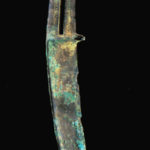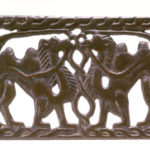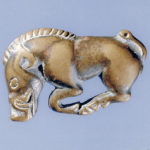The exquisite artworks of the nomadic peoples of Asia are the focus of this temporary exhibit. Ancient Bronzes of the Asian Grasslands from the Arthur M. Sackler Foundation highlights the creativity, beliefs, and daily life of the inhabitants of the huge region known as the steppes, the grasslands of eastern Europe and Asia.
Just as the introduction of the horse to Native Americans of the North American plains permitted their nomadic lifestyle, so too did the much earlier domestication of the horse in the Eurasian steppes allow the spread of peoples far and wide from northern China, across Mongolia, and into the Eastern European plains by 1400 BC. The steppe peoples made their living by managing herds of sheep, goats, cattle, and horses, and the latter meant that herdsmen could range farther for grass and keep larger flocks and herds. Trade was also important as the steppe peoples supplied meat, wool, and leather to Asian city dwellers, from whom they obtained agricultural produce and manufactured goods in return. By the early eighth century BC, they also supplied horses to the empires of China and western Asia, and guided and supplied the trade caravans that traveled the routes of the famous Silk Road.
The art objects of the steppe peoples were those that could be easily carried. Bronze was the material of choice because of its strength, light weight, and resilience, and it was fashioned into tools, weapons, vessels, and ornaments for clothing. Decorations for horses also were made of bronze. Plaques, buckles, and pendants feature an array of representational and abstract animals, including deer, birds, wild goats, bear, wild boar, wild cats such as leopards and Siberian tigers, and frogs, as well as horses and camels. These symbolized membership in a social group such as a clan, or animal spirits who could be contacted by a shaman, a religious practitioner. The objects also indicated social and economic status.
Influences from China can also be seen in the art of the steppes. Weapons of Chinese style and decorative motifs like the imperial dragon point to the many relationships with ethnic Chinese, which included intermarriage as well as economic ties. The works of the collection from which the exhibit is drawn were acquired in China largely during the 1920s and ‘30s by several individuals, teachers, and missionaries, who lived and worked in northern China. Arthur M. Sackler (1913–1987), a research psychiatrist and publisher, acquired the pieces in the late 1950s and early 1960s. He formed the Arthur M. Sackler Foundation in 1965 to make his art collections available for viewing by the general public. The Foundation has donated and loaned art to museums in the United States, published catalogues of works of art, and organized exhibitions such as this one.
- Knife, Northwestern China, 13th-11th century BCE
- Buckle plaque (V-7021) Bronze Southern Siberia, 2nd century BCE
- Bronze ornament from Northern China or Inner Mongolia, 5th-3rd century BCE.
Trudy S. Kawami is the curator of Ancient Bronzes of the Asian Grasslands from the Arthur M. Sackler Foundation. Exhibition sponsors include the Wildcat Cove Foundation and the Aletha and Clayton Brodine Museum Fund.



